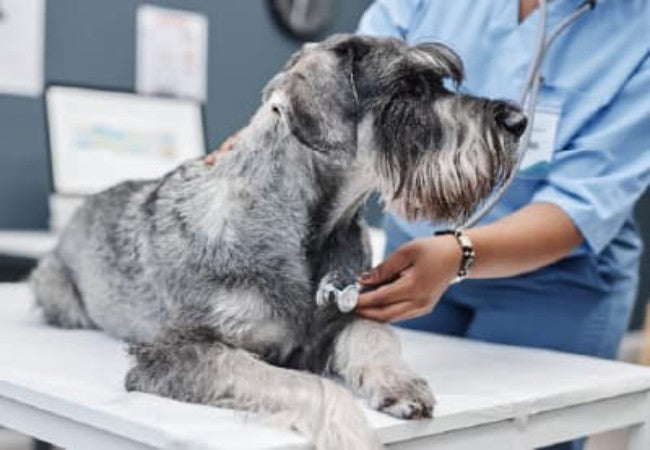Atrioventricular Valve Endocardiosis in Dogs: 2025 Vet Guide 🩺🐶

In this article
Atrioventricular Valve Endocardiosis in Dogs: 2025 Vet Guide 🩺🐶
By Dr. Duncan Houston BVSc
Hello! I’m Dr Duncan Houston, BVSc, veterinarian and founder of Ask A Vet. This comprehensive 2025 guide dives into atrio‑ventricular (AV) valve endocardiosis, also known as myxomatous mitral or tricuspid valve degeneration—a leading cause of canine heart disease. We’ll cover its causes, diagnosis, treatment strategies, home management, prognosis, and how telehealth enhances care.
1. 🩺 What Is AV Valve Endocardiosis?
AV valve endocardiosis is a chronic degenerative disease affecting the mitral and/or tricuspid valves, especially the mitral on the left side. The valve leaflets thicken and form nodules, losing proper sealing ability. As a result, blood leaks back into the atrium during systole (regurgitation), leading to volume overload, chamber enlargement, and eventually congestive heart failure (CHF). It is the most common heart disease in dogs, responsible for ~75% of cardiovascular cases.
2. 🐕 Who’s Affected?
- Breed predisposition: Small breeds like Cavalier King Charles Spaniels, Chihuahuas, Miniature Schnauzers, Maltese, Pomeranians, Cocker Spaniels, and Boston Terriers are most affected.
- Age of onset: Early valve changes detected around age 6–8 in Cavalier King Charles; CHF most common at 10–12 years.
- Sex: Males are slightly more predisposed (approx. 1.5×).
3. ⚠️ Why It Matters
As valves degenerate, regurgitation worsens, causing progressive enlargement of the left atrium and ventricle, pulmonary congestion, and eventually CHF. In severe cases, left atrial rupture can even cause fatal tamponade.
4. 🩺 Clinical Signs & Detection
- Early: Heart murmur during routine exam, often asymptomatic.
- Progressive stages: Coughing, exercise intolerance, rapid or labored breathing, fainting, fatigue, abdominal swelling (ascites).
- Advanced CHF: Orthopnea (elbows extended to aid breathing), bluish mucous membranes, syncope.
5. 🧪 Diagnostic Workflow
- Physical exam: Identify murmur, exam for cough, and respiratory changes.
- Chest X-rays: Assess heart enlargement and pulmonary fluid.
- ECG: Detect arrhythmias commonly associated with endocardiosis.
- Echocardiography: Gold standard—visualize valve thickening, regurgitation severity, and chamber enlargement.
- Bloodwork: Check kidney function, electrolytes, and identify CHF sequelae.
- Staging: ACVIM stages A-D determine treatment, ranging from at-risk (A) to end-stage CHF (D).
6. 🛠 Treatment Strategies
a. Early or Asymptomatic (Stages A/B1)
Monitor: Semi-annual checkups with auscultation, chest x-rays, and echo. No drug therapy unless echo shows heart enlargement (stage B2).
b. Preclinical but with Enlargement (Stage B2)
- Pimobendan: Delays CHF onset—standard for B2 dogs.
- ACE inhibitors: May be added in enlarged hearts (benazepril, enalapril).
- Diet: Mild sodium restriction.
c. Symptomatic or CHF Present (Stages C/D)
- Diuretics: Furosemide initially, followed by lower doses. Spironolactone adds RAAS blockade.
- Pimobendan: Continues to support heart function.
- ACE inhibitors & mineralocorticoid blockers: Combine for optimal RAAS management (e.g., Cardalis™ combo).
- Advanced interventions: In specialized centers, chordal repair techniques like MI‑4 can dramatically reduce regurgitation and medication use at 12-month follow-up.
- Oxygen & cage rest: Stabilize during acute CHF episodes.
d. Monitoring & Follow-up
- Recheck physical exams and chest x-rays every 6–12 months.
- Monitor blood tests for kidney-electrolyte balance.
- Repeat ECG if arrhythmias are suspected.
- Assess the echo periodically to check heart size and valve changes.
- Owners monitor resting respiratory rate (>40 BPM is a warning sign).
7. 🏡 Home & Lifestyle Management
- Offer leash walks; reduce strenuous activity.
- Provide a sodium-restricted diet to reduce fluid retention.
- Observe for coughing, breathing changes, and weakness. Report concerns early.
- Administer meds as prescribed and track using telehealth apps.
8. 🌐 Telehealth & 2025 Innovations
- Wearable ECG patches: Monitor arrhythmias at home.
- AI-assisted echo and ECG interpretation: Flag changes earlier.
- App reminders: Medication schedules, vet visit prompts.
- Virtual consults: Discuss test results remotely.
- Integrated follow-up: Automated alerts for rising respiratory rate or weight gain.
9. 📈 Prognosis
- Slow to severe progression—median survival varies; with pimobendan, many B2 dogs remain stable for years; symptomatic dogs have shorter timelines.
- Advanced surgical repair (MI‑4) shows reduced regurgitation and medication use in follow-ups.
- Risk factors for poorer outcome: older age, high murmur grade, CHF onset, arrhythmias, rapid heart failure progression.
10. ❓ FAQs
- Can my dog live a full life?
- Yes—with early diagnosis and treatment, many live comfortable, productive lives.
- What if surgery isn't possible?
- Medications effectively control symptoms; telehealth keeps care responsive.
- Is it hereditary?
- Likely in breeds like CKCS; avoid breeding affected dogs.
- When should I call the vet?
- Any new cough, difficulty breathing, fainting, or reduced appetite/exercise tolerance.
11. ❤️ How Ask A Vet Supports You
With Ask A Vet, you receive:
- Remote echo/ECG uploads and cardiologist review.
- Medication reminders and symptom tracking tools.
- Wearable device integration with specialist monitoring.
- Virtual consults to adjust care and plan follow-up.
- Coordination with local clinics for diagnostics and emergency care.
Download our app to bring expert cardiology support into your home. 🐾❤️
12. 🔚 Final Summary
Atrioventricular valve endocardiosis remains the top acquired canine heart disease. While progressive, early detection, staging, and evidence-based treatment—including pimobendan, RAAS modulation, and advanced surgical techniques—can significantly improve outcomes. Lifestyle adjustments and diligent home monitoring bolster treatment success, and modern telehealth allows real-time oversight. With compassionate partnership between you and your vet (and Ask A Vet), your dog can live a rich, heart-healthy life well into their golden years.
— Dr Duncan Houston, BVSc






